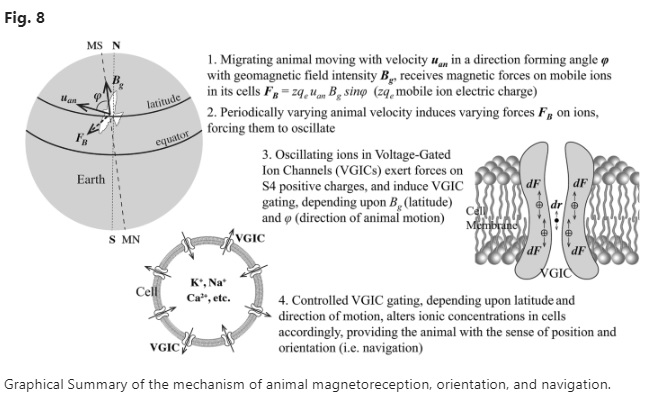Ref. Panagopoulos, D.J., Karabarbounis, A. & Chrousos, G.P. Biophysical mechanism of animal magnetoreception, orientation and navigation. Sci Rep 14, 30053 (2024) https://www.nature.com/articles/s41598-024-77883-9
Summary
The authors describe a biophysical mechanism for animal magnetoreception, orientation and navigation in the geomagnetic field (GMF), based on the ion forced oscillation (IFO) mechanism in animal cell membrane voltage-gated ion channels (VGICs) (IFO-VGIC mechanism).
•Review of Hypotheses We review previously suggested hypotheses; describe the structure and function of VGICs and argue that they are the most sensitive electromagnetic sensors in all animals.
•Magnetic Forces on Ions: We consider the magnetic force exerted by the GMF on a mobile ion within a VGIC of an animal with periodic velocity variation.
•IFO Equation Application: We apply this force in the IFO equation resulting in solution connecting the GMF intensity with the velocity variation rate.
•Key Findings: We show that animals with periodic velocity variations, receive oscillating forces on their mobile ions within VGICs, which are forced to oscillate exerting forces on the voltage sensors of the channels, similar to or greater than the forces from membrane voltage changes that normally induce gating.
•Conclusion: Thus, the GMF in combination with the varying animal velocity can gate VGICs and alter cell homeostasis to a degree depending, for a given velocity and velocity variation rate, on GMF intensity, that is unique in each latitude, and the angle between the velocity and GMF axis, which determine animal position and orientation.
Graphical Summary of the mechanism of animal magnetoreception, orientation, and navigation.

Comments by Dimitris J. Panagopoulos (PhD), (EMF-biophysicist, National Kapodistrian University of Athens, Greece)
This study resolves one of the greatest enigmas in science that had remained unexplained
till today: How migrating animals orient and navigate on Earth, traveling many thousands of
kilometers and finding exact locations. In other words, how animals sense the GMF intensity and
direction, and finally, how they can sense electromagnetic fields (EMFs) in general.
According to Johnsen and Lohmann (2008), “determining how animals orient themselves using Earth’s magnetic field can be even more difficult than finding a needle in a haystack. It is like finding a needle in astack of needles.”
The basic IFO-VGIC model for the action of EMFs on cells
The basic IFO-VGIC model for the action of EMFs on cells has been published since 2000 in successive publications (Panagopoulos et al 2000; 2002; 2015; 2021; 2024) and is widely recognized as an accepted mechanism, referenced until today in more than 1,000 other scientific publications. It has explained, among other phenomena, the sensing of atmospheric discharges (lightning) by sensitive individuals (Panagopoulos and Balmori 2017) and the sensing of upcoming earthquakes by animals (Panagopoulos et al 2020), in addition to the explanation of all known bioeffects of man-made EMFs. Yet, it was unnoticed by people working on animal magnetoreception who insisted on complicated hypotheses involving “magnetite” or “light-induced cryptochrome radical-pairs”, and hypothetical cells/organs named “magnetoreceptors” or “electroreceptors” supposedly located in the eyes, or the ears, or even the hair of various animals.
This publication points out the impossibilities of those hypotheses, and illuminates the fact that all cells in
all animals (and even plants), especially nerve and brain cells, are equipped with VGICs, the most
abundant type of ion channels in all cell membranes and the most sensitive electro-magneto-receptors.
The study, together with the ample experimental evidence that man-made EMFs at even very low
intensities can affect VGICs and modify ion currents, is an additional confirmation of the IFO-VGIC
mechanism which explains all known biological and health effects of both the totally polarized man-
made EMFs, and those natural EMFs that are significantly polarized such as the GMF.
Finally, this
publication is the answer to those who still claim that “there is no accepted mechanism for EMF-
bioeffects”.
Source: New Scientific Publication by Panagopoulos et al., 2024 https://www.emfsa.co.za/wp-content/uploads/2024/12/New-scientific-publication-by-Panagopoulos-DJ-et-al.pdf
Conclusion
This study not only elucidates the mechanisms behind animal navigation and magnetoreception but also highlights the broader implications of VGIC sensitivity to electromagnetic fields. For further insights into this topic, explore the comprehensive works of Dr. Panagopoulos https://www.researchgate.net/profile/Dimitris-Panagopoulos-3
- Related Reading: Electromagnetic Fields of Wireless Communications: Biological and Health Effects, edited by Dimitris J. Panagopoulos, CRC Press (2019). This book explores bioeffects of EMFs in greater detail and is now available in a softcover edition at reduced cost.
- Video 2019: Dr. Dimitris Panagopoulos: Electromagnetic Fields – Health Effects – Mechanism of Action https://www.emfsa.co.za/videos/dr-dimitris-panagopoulos-electromagnetic-fields-health-effects-mechanism-of-action/
